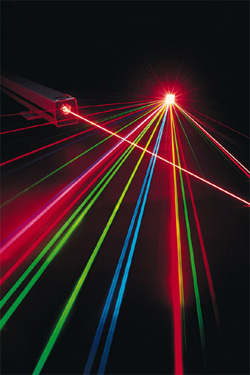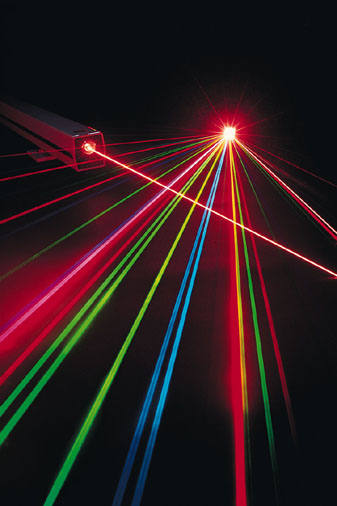Laser from Atomic Nuclei
For years, physicists have wanted to make a nuclear laser–one that depends on the excitation of nuclei rather than of electrons. A proposal in the 22 April Physical Review Letters suggests a path to creating such a laser, relying on some quirks of the nuclear structure of thorium. The laser would emit visible light, not the gamma rays usually associated with nuclear radiation. A nuclear laser could provide a new basis for measuring time–imagine a nuclear clock, rather than an atomic clock–and tests for many fundamental properties of nature, such as the possible variation in fundamental constants over time.
“The real gamma-ray laser is a dream of military science,” says Eugene Tkalya of Moscow State University in Russia, although he says the interest from physicists has been for studying fundamental physics. Not many electronic transitions in atoms emit gamma rays, so researchers have looked to transitions in the atomic nucleus. However, the gamma-ray laser, or graser, has faced heavy skepticism, as illustrated by Los Alamos National Lab physicist Hans Frauenfelder’s 1973 comment after a talk by Vitali Goldanskii of the Institute of Chemical Physics in Moscow: “Dear Vitali, I always thought a gamma laser is impossible. After your talk it seems many orders of magnitude less impossible. But still I consider it impossible.”
The two major challenges have been to find an appropriate nuclear transition that can be effectively excited in the lab and to create a so-called population inversion, where there are more excited than unexcited nuclei, which is necessary for lasing. To solve these problems, Tkalya proposes a nuclear laser in the visible range of wavelengths, not gamma rays. But it would be the first nuclear laser and the closest approach yet to a gamma-ray laser.
The scheme involves replacing some calcium with thorium in a lithium-calcium-aluminum-fluoride ( ) compound. Through the luck of nature, the thorium nucleus in this material has a 10 electron-volt transition from its ground state to an excited state, and the transition is separated in energy from the electron transitions in the atom. That means visible photons of the right frequency could avoid the electrons and interact with the nucleus directly, according to Tkalya’s calculations.
To create a population inversion, Tkalya proposes borrowing a trick from standard atomic lasers–making use of a third energy level, in addition to the ground and excited states of the nucleus. By applying either a strong magnetic field of about 100 tesla or a strong electric field gradient of about volts per square centimeter, experimentalists could split the ground state into several closely spaced energy levels. The upper ones are usually empty (nuclei in these states decay rapidly to the true ground state), so one of them could serve as the lower state for the lasing process. In Tkalya’s scheme, thorium nuclei would be pumped to a specific, long-lasting, excited state with photons from an ultraviolet laser, giving this state a higher population than the not-quite-ground state. This population inversion would lead to lasing.
Another issue for a nuclear laser is that the nuclei must emit radiation without recoiling, as a significant recoil would mean a photon is emitted with a shifted frequency and could not stimulate emission in other nuclei. As in other nuclear laser schemes, Tkalya shows that this problem is solved by the Mössbauer effect, in which nuclei in a solid don’t recoil individually but cause the entire lattice to recoil a minuscule amount. This participation of the lattice keeps the emitted photon at the right frequency to stimulate other nuclei.
“Tkalya appears to succeed where others have failed in large part because the nuclear transition he has chosen has a much lower transition energy,” says Eric Hudson of the University of California, Los Angeles. “Work like this takes us closer to being able to coherently interact with and control atomic nuclear states.” Hudson says the nuclear laser could enable technologies such as better time keeping, quantum information processing, and novel radiation sources.
–David Harris
David Harris is a freelance science writer in Palo Alto, California.





